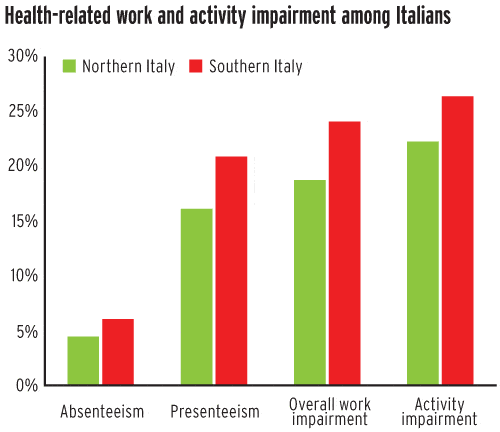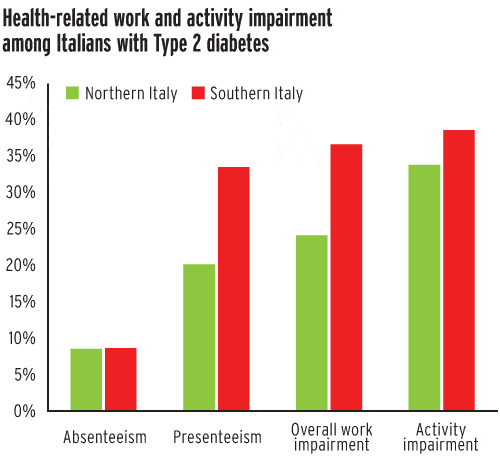
Although aggregating data to regional or national level is often sufficient to answer the question at hand, there are also situations where generalising from a national level hides important distinctions. Italy is a good example where thinking of the state as a single entity can be too simplistic, where looking only at the whole might result in missing important distinctions, challenges and opportunities within the country.
This complexity is reflected in the highly regionalised structure of Italy’s healthcare system; though healthcare policy (Piano Sanitario Nazionale; PSN) and reimbursement are determined nationally, regional governments implement PSN with their own resources and can make adjustments to suit the specific needs of the region, including setting patient co-payments.
The 7,500 Italians in each fielding of the National Health and Wellness Survey (NHWS) live in all 20 regions of the Italian Republic, in numbers roughly proportional to the population. The first distinction most people make when thinking of Italy is between the North and South – a distinction that is also reflected in the health disparities literature.
Common sense suggests that people living in the foothills of the Alps may have a different set of health challenges from those living near the Straits of Messina. There are even those who take a more extreme view, believing that Italy is best thought of not as a single country, but as two or even more.
There is a long history behind this; the south of Italy, referred to as il Mezzogiorno in Italian (which literally translates to Midday), includes the regions south of Rome as well as Abruzzo (directly east of Rome) and the islands of Sicily and Sardinia; for the purposes of this exercise, we have grouped Rome and the rest of Lazio with the South.
The South is a beautiful place, known for its beaches, Greek ruins and Neapolitan pizza, but it has comparatively little economic development.
North and South were ruled by different regimes prior to unification in 1861, and economic conditions in the South have long spurred considerable migration to northern Italy, elsewhere in Europe and the Americas.
In contrast to the South, northern Italy is part of the ‘blue banana’, the main corridor of economic activity in Europe. Turin and Milan are global centres of design and manufacturing; the home of FIAT, Giorgio Armani and innumerable other global brands (including Kantar Health’s Italian offices). There is even a saying about the business orientation of the North: “For every church in Rome, there is a bank in Milan.” But does this translate to different health outcomes?
The North South divide
The existing literature on health disparities between northern and southern Italy has focused on the frequency of poor self-rated health. Usually this is done in a very simple manner, such as asking an individual to indicate his overall health as excellent, good, fair, poor or very poor, with ‘poor self-rated health’ being a response of ‘poor’ or ‘very poor’.
This measure has found health to be worse in the South than in the North. Though not directly comparable because of differences in the response options, Italian respondents to the NHWS also display higher rates of poor self-rated health as assessed by the general health question of the SF-12v2 Health Survey (Ware J, Kosinski M, Turner-Bowker D, Gandek B SF-12v2: How to Score Version 2 of the SF-12 Health Survey. Quality Metric Incorporated Health Assessment Lab Boston, Massachusetts. Lincoln, Rhode Island. 2002), with 6.8 per cent in the North and 10.5 per cent in the South rating their health as poor.
However, the NHWS collects considerably more information from each respondent than is generally collected in such research, including the validated Work Productivity and Activity Impairment questionnaire (Reilly MC, Zbrozek AS, Dukes EM. The Validity and Reproducibility of a Work Productivity and Activity Impairment Instrument. Pharmacoeconomics. 1993;4 (5):353).
This scale allows for the calculation of absenteeism (work missed due to health), presenteeism (impairment due to health while at work) and overall work impairment (the combination of absenteeism and presenteeism) in the preceding seven days. Impairment in non-work activities is also assessed. As these measures have not been available in other studies of the North-South disparity, the focus of this analysis was to compare northern and southern Italy in terms of health-related impairment to work and non-work activities.

When the whole of the employed population was examined, significant differences between North and South were seen in health-related impairment both at work and at home. Health-related work impairment in residents in il Mezzogiorno was 28 per cent higher than in the North. Across the entire population residents of southern Italy were 19 per cent more impaired in non-work activities.
Disease-related impairment
Because regional differences could potentially be explained by differences in prevalence of disease, North and South were also compared using specific patient populations. For example, when looking at the Type 2 diabetes (T2D) population in Italy, we see that overall work impairment among southern Italian T2D patients is 36 per cent, one and a half times as great as the 24 per cent impairment experienced by employed T2D patients in northern Italy.

The pattern is consistent, albeit less pronounced, in hypertension. Employed Italians with hypertension living in the South miss a comparable amount of work due to health as their northern neighbors but display 26 per cent more health-related productivity impairment (presenteeism) while at work and 15 per cent greater overall work impairment. Impairment in activities of daily living is likewise 16 per cent greater in the South.
However, despite these regional disparities in outcomes, it is not because southern Italians are going untreated. North and South have equivalent rates of treatment for both T2D and hypertension.
As expected, there are differences in household income, so some of the discrepancies may be tied to income or related factors, such as the type of work the person is engaged in.

Equivalent problems in physical health may have different effects on more and less physically demanding work, and the type of work would be expected to differ by region.
Differences between northern and southern Italy are numerous, and our data shows that health is no exception. Those living in il Mezzogiorno were more likely to rate their health as poor in the SF-12v2 and also reported greater impairment to work and activities than those residing in northern Italy. This pattern was consistent both across the adult population as a whole as well as within individual patient populations.
Regional analyses such as these can serve to facilitate discussions with officials whose decisions are based on considerations at a more local level and may allow for better co-pay levels in countries such as Italy, where the national government leaves such decisions to regional administrators. Such analyses may also provide more opportunities for market access, where highlighting high regional burden of disease may reveal otherwise hidden unmet needs.




